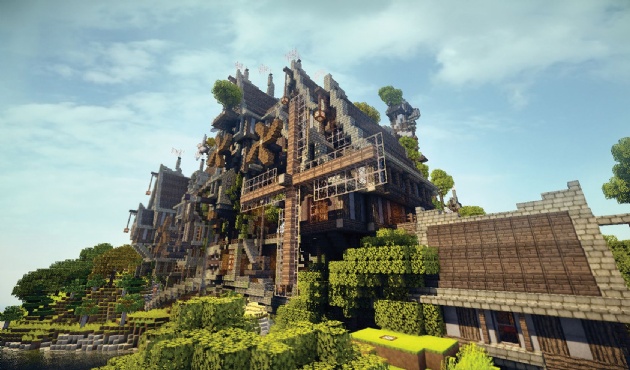The holidays are almost here and the influx of gift ideas
has flooded our minds and poked at our wallets. Now I am going to safely assume
that video games will probably be among the favored purchases. Unfortunately,
quite similarly to the movie industry, the greatest hits in games are the big
budget, profit-generating, plug-and-play joyrides. Most blockbuster game titles
seem hard to detach from safe stereotypes like oversimplified tasks, repetitive
game-play and meaningless rewards because they are profitable and recyclable.
Maybe it's just me, but I bet that a lot of people are getting fed up of
dishing out the standard $60 for the next “it” game just to find out it’s the
same style of game that has been marketed for the past decade. That's our cue
to start viewing video games under a different light and to start opening our
eyes to the little players in the business. Independent developers are
currently challenging mainstream games and introducing newer and more creative
designs into their games. Luckily for me, I have witnessed firsthand what this
looks like. Here is how these independently developed games kept me thoroughly
entertained and, as a bonus, cut down the cost of my hobby to an average of $30.
Let's start off with a little
game called Minecraft. This game has brought
about a great deal of discussion to players and game developers alike due to
its overwhelming success. Just in case you haven't heard about it, let me give
you a quick overview. You punch/chop/mine your way through various "natural"
(we are, after all, in a game) resources in order to craft/build items,
structures and just about anything you can think of. The game's crafting
mechanics and endless exploration have won over the heart of millions of
players (including myself). It features an infinite amount of replay value and
offers players the chance to express their creativity in a beautifully
pixelated world. Mojang studios, the creators of Minecraft, now boast of a
spectacular 500 million copies sold (well-deserved success for an expertly
crafted video game). Minecraft captures the very essence of a good game by
basically providing you with an oversized sandbox full of rich, creative
content and depth, allowing the player to thrive in the game world. What's best
is that the studio keeps working on it to maintain and provide additional
content through free patches and updates.
Thomas Was Alone is another short form
game that has caught my attention. It's a 2D platformer where you play as
Thomas, who is just a cube. You progress through the story and solve puzzles by
leaping through levels and finding your way to the end. Thomas ends up meeting
other blocks of different sizes, each with their own unique platforming
abilities. Together you must use them to overcome more complicated obstacles as
you play the game. The game combines perfect platforming mechanics and tight
controls, building upon what made classics like Super Mario Bros. and Mega
Man the hits that they are today. The developer also uses the game
mechanics and clever narration to breathe life into an otherwise extremely
simplistic world of flat, monochromatic colors and shapes. The narrator in the
game, crafts a beautiful story of friendship and the importance of teamwork by personifying
the different cubes you role-play. What struck me most was that the narrator
builds human-like characteristics around the platforming mechanics used for
each cube. As you get further into the game, you get introduced to one
character whose only purpose seems to be weighing you down. The cube is slow
and excessively big making it hard to get around the levels. You are forced to
use the others as leverage to make it hop over some of the obstacles. In the
story, the cube is introduced as an embarrassed and introverted person. As
you're playing, you can actually see and feel the link between the clumsiness
of the square and the narration going on in the background. I found it
absolutely amazing that this developer chose the simplest of visuals (squares
hoping over stuff) to use as a canvas for his story. It's practically a
statement that given, we can see visual interaction on a screen, creativity and
story-telling emerging solely through the use of game mechanics.
For our
last indie game, let's take the game called Antichamber.
Whatever you think you know about physics and reality, gets lost within the
walls of this mind-warping game. Developer Alexander Bruce takes players on an
adventure that I'm not quite sure how to explain, even after
"finishing" the game. Dropped into what seems to be a white,
corridor-filled environment, where sometimes backwards or upside down is the
only way forward through the game. The game engine and level design powering
Antichamber translates into the most flattering use of the first person
perceptive I've ever experienced in any game of that genre. Not to mention the
puzzles in the game also had me sitting in my computer chair for what seemed
like an eternity. All in good spirit of course! There’s nothing like treating
the mind to a meticulously designed puzzle system, forcing oneself to think
beyond conventional perception.
That being
said, I am definitely more excited that the newer generation of game devs are
trying something a little more daring this time around. What's better is that
bigger companies are opening their doors to independent developers. For
instance, Sony and Nintendo are maintaining a healthy relationship with indie
devs by letting them publish their own games on their consoles. Everyone enjoys
the entertainment and technology behind the bigger games, of course, and I'm
not saying that indie games are the end-all, be-all video game paragons. I’m
only stating that it's the simple and effective game mechanics alongside the
creative direction of the designers that make way for fantastic gaming experiences.

 In The Latest Issue:Latest Issue:
In The Latest Issue:Latest Issue:
- Celebrating Community an...
- Celebrating the Unsung H...
- Understanding Newborn St...
Articles
Calendar
Virtual- ANNUAL TEACHER APPRECIATION CONTEST
- APPUI LAVAL
- ARTS & CULTURE
- CAMPS
- CAR GUIDE
- CCIL
- CENTENNIAL ACADEMY
- CHARITY FUNDRAISING
- CITYTV
- COSMODÔME
- COMMUNITY CONNECTIONS
- COVER STORY
- DINA DIMITRATOS
- ÉCOLE SUPÉRIEURE DE BALLET DU QUÉBEC
- EDITORIALS
- ÉDUCALOI
- EDUCATION
- EMPLOYMENT & ENTREPRENEURSHIP
- FÊTE DE LA FAMILLE
- FÊTE DU QUARTIER SAINT-BRUNO
- FAMILIES
- FESTIVAL LAVAL LAUGHS
- FÊTE DE QUARTIER VAL-DES-BRISES
- FINANCES
- GLI CUMBARE
- GROUPE RENO-EXPERT
- HEALTH & WELL-BEING
- 30 MINUTE HIT
- ANXIETY
- CHILDREN`S HEALTH & WELLNESS
- CLOSE AID
- DENTAL WELLNESS
- EXTREME EVOLUTION SPORTS CENTRE
- FONDATION CITÉ DE LA SANTÉ
- GENERAL
- HEARING HEALTH
- MESSAGES FROM THE HEALTH AGENCY OF CANADA
- MENTAL HEALTH
- SEXUALITY
- SOCIAL INTEGRATION
- SPECIAL NEEDS
- TEENS
- THE NUTRITION CORNER
- THE NUTRITION CORNER - RECIPES
- VACATION DESTINATION
- WOMEN'S FITNESS
- WOMEN'S HEALTH
- HILTON MONTREAL/LAVAL
- HOME & GARDEN
- INTERNATIONAL WOMEN'S DAY
- JAGUAR LAVAL
- LAVAL À VÉLO
- LAVAL FAMILIES TV SHOW
- LAVAL FAMILIES MAGAZINE CARES
- LAVAL URBAN IN NATURE
- LE PARCOURS DES HÉROS
- LES PETITS GOURMETS DANS MA COUR
- LEON'S FURNITURE
- LEONARDO DA VINCI CENTRE
- LFM PREMIERES
- LIFE BALANCE
- M.P. PROFILE
- MISS EDGAR'S AND MISS CRAMP'S SCHOOL
- MISSING CHILDREN'S NETWORK
- NETFOLIE
- NORTH STAR ACADEMY LAVAL
- OUTFRONT MEDIA
- PASSION SOCCER
- PARC DE LA RIVIÈRE-DES-MILLE-ÎLES
- PÂTISSERIE ST-MARTIN
- PIZZERIA LÌOLÀ
- PLACE BELL
- PORTRAITS OF YOUR MNA'S
- ROCKET DE LAVAL
- SACRED HEART SCHOOL
- SCOTIA BANK
- SHERATON LAVAL HOTEL
- SOCIÉTÉ ALZHEIMER LAVAL
- STATION 55
- STL
- SUBARU DE LAVAL
- TECHNOLOGY
- TEDXLAVAL
- TODAY`S LAURENTIANS AND LANAUDIÈRE
- TODAY`S LAVAL
- WARNER MUSIC
- THIS ISSUE
- MOST RECENT
Magazine
The Next Generation of Video Gamers
Articles ~e 105,7 Rythme FM 4 chemins Annual Teacher Appreciation Contest Appui Laval Arts & Culture Ballet Eddy Toussaint Camps THIS ISSUE MORE...
CONTESTS Enter our contests
CONTESTS Enter our contests
CALENDAR
Events & Activities
COMMUNITY Posts Events
PUBLICATIONS Our Magazine Family Resource Directory
LFM BUSINESS NETWORK Learn more
COUPONS Click to save!
COMMUNITY Posts Events
PUBLICATIONS Our Magazine Family Resource Directory
LFM BUSINESS NETWORK Learn more
COUPONS Click to save!
SUBSCRIPTIONS
Subscribe to the magazine
Un-Subscribe
E-NEWSLETTER Subscribe to our E-newsletter Un-Subscribe
WRITE FOR US Guidelines & Submissions
POLLS Vote today!
E-NEWSLETTER Subscribe to our E-newsletter Un-Subscribe
WRITE FOR US Guidelines & Submissions
POLLS Vote today!
ADVERTISERS
How to & Media guide
Pay your LFM invoice
SUGGESTIONS Reader's Survey Suggest a Listing
LFM About Us Our Mission Giving Back Contact Us
SUGGESTIONS Reader's Survey Suggest a Listing
LFM About Us Our Mission Giving Back Contact Us
 PICK-UP LOCATIONS
Get a copy of LFM!
PICK-UP LOCATIONS
Get a copy of LFM!
TERMS & CONDITIONS Privacy | Terms
ISSN (ONLINE) 2291-1677
ISSN (PRINT) 2291-1677
Website by ZENxDESIGN



 BY:
BY: 


Tweet
Share